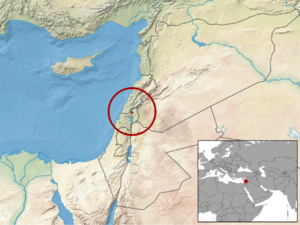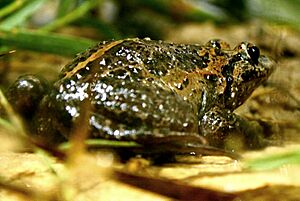Hula painted frog facts for kids
Quick facts for kids Hula painted frog |
|
|---|---|
 |
|
| Conservation status | |
| Scientific classification | |
| Genus: |
Latonia
|
| Species: |
nigriventer
|
 |
|
| Synonyms | |
|
Discoglossus nigriventer Mendelssohn and Steinitz, 1943 |
|
The Hula painted frog (Latonia nigriventer) is a special kind of frog. It lives only in the Lake Hula marshes in northern Israel. This frog is the only living member of its group, called Latonia. Other frogs in this group are only known from very old fossils.
For many years, people thought the Hula painted frog was extinct. This happened because its home was destroyed in the 1950s. But then, in 2011, this amazing frog was found again!
The draining of Lake Hula and its marshes in the 1950s was a big problem. It was believed to have caused this frog to disappear. Only five of these frogs had ever been seen before the lake was drained. Luckily, improvements in the Hula nature reserve helped the frog reappear.
Contents
What Does the Hula Painted Frog Look Like?
The Hula painted frog has a dark belly with small white spots. Its back is a yellowish-brown color. This color slowly changes to dark olive-grey or black on its sides.
This frog is different from other painted frogs. It has wider-set eyes and longer front legs. Its snout also sticks out less. The first frog studied by scientists was a female. It was about 40 mm (1.6 in) long.
Scientists didn't know much about this frog for a long time. This is because very few were ever found. Two adult frogs and two tadpoles were collected in 1940. Then, only one more frog was found in 1955. This was the last time anyone saw the species until 2011.
The frog's Hebrew name is agulashon shehor-gahon. This means "Black-bellied round-tongued." It describes the frog's black belly and round tongue. Unlike other frogs, its tongue is not used to catch food.
This frog was first thought to be in the Discoglossus group. But after it was found again, scientists studied its genes and body. They moved it to the Latonia group. No other living frogs are known in this group. Because of this, the Hula painted frog is called a "living fossil." It is the only living example of a very old frog family.
Why Is This Frog Important?
In 1996, the IUCN said this frog was "extinct in the wild." It was the first amphibian ever given this sad title. Israel still hoped a few might be found. They thought some could be living in the Golan Heights or southern Lebanon.
After the frog was found again in 2011, the IUCN changed its status. Now, the Hula painted frog is "critically endangered." This means it is at very high risk of disappearing forever. Its known home is very small, less than 2 km2.
In 2000, a scientist thought he saw this frog in Lebanon. But later searches in 2004 and 2005 did not find any. In 2010, a big search for frogs thought to be extinct began. The Hula painted frog was one of the species they looked for.
How Was the Frog Rediscovered?
In 2011, a park ranger named Yoram Malka was on patrol. He was at the Hula Nature Reserve. He found a frog that he immediately thought was the Hula painted frog. He had been looking for it for many years! Scientists later confirmed it was indeed this rare species.
An expert from the Israel Nature and Parks Authority said the area's water levels had improved. This was likely why the frog was seen again. A second Hula painted frog was found on November 29. It was a female, found in swampy plants. Since the first discovery, at least ten more frogs have been found. All of them were in the same small area.
New Ways to Find Frogs
In 2016, a team of scientists found hundreds of these frogs. They looked in water at night instead of in the mud. They found frogs in 17 out of 52 water holes they checked in the Hula Valley.
In 2017, scientists used a new method called environmental DNA (eDNA). This helps find rare animals like the Hula painted frog. eDNA means they look for tiny bits of the frog's DNA in the water. This method is very good at finding animals that are hard to see.
Researchers took water samples from 52 places. They found Hula painted frog DNA in 22 of these places. Most of these spots were near the Hula Nature Reserve. This shows how important nature parks are for protecting wildlife. Finding these places helps scientists know where to protect the frogs in the future.
Understanding the Frog's Population
In 2018, another study looked at the frog's population. They found that there are not many of these frogs. They also don't move around much. This means they need urgent help to survive. Scientists estimated there are about 234-235 adult frogs that can reproduce.
Even though there are few frogs, they have good genetic diversity. This is surprising for such a small group. It might mean there is another group of frogs somewhere that scientists haven't found yet.
Future research is very important for this frog. Scientists need to find other places where these frogs might live. The frog's watery homes are easily disturbed by people. This puts the endangered Hula frogs at risk. Finding and protecting safe places for them is key to saving the only living member of the Latonia group.
See also
- Wildlife of Israel



